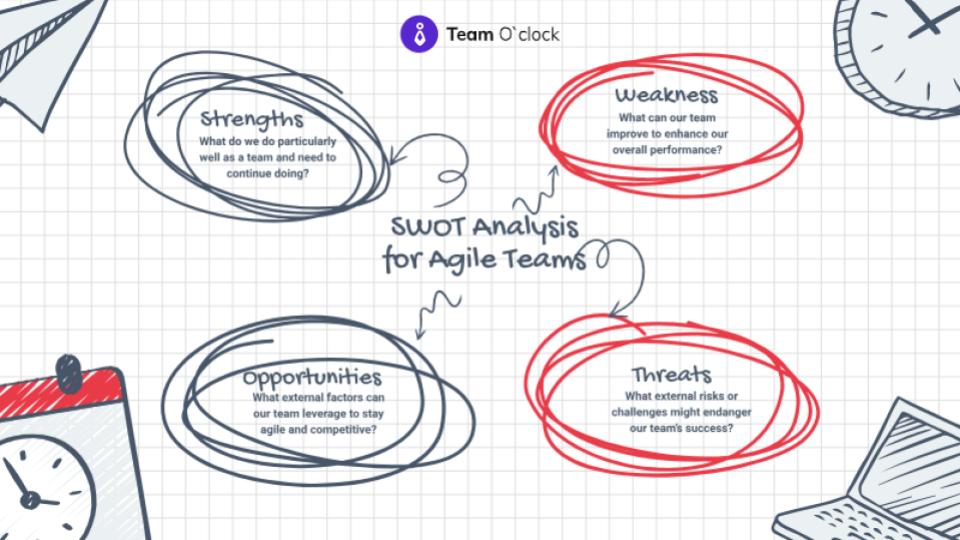
How to Conduct SWOT Analysis in Agile

Agile methodologies focus on delivering iterative improvements, fostering adaptability, and ensuring continuous feedback. However, as Agile teams grow and evolve, they face various challenges, both internal and external, that can impact productivity, decision-making, and long-term performance.
This is where SWOT analysis becomes particularly useful. By leveraging a SWOT analysis in an Agile setting, teams can more systematically assess their strengths and weaknesses, identify opportunities for innovation, and anticipate potential risks.
This approach aligns well with Agile principles like continuous improvement (Kaizen), transparency, and adaptability, helping teams become more self-aware and proactive in tackling obstacles.
What is a SWOT analysis?
A SWOT analysis is a strategic planning tool used to evaluate the Strengths, Weaknesses, Opportunities, and Threats related to a project, organization, or process. It provides a comprehensive view by categorizing internal factors (Strengths and Weaknesses) and external factors (Opportunities and Threats) that can influence success.
Originally designed for business strategy, the SWOT analysis framework is widely applied across industries and disciplines to assess current performance and future potential.
Why SWOT Matters in Agile
Self-assessment and regular reflection are central to Agile practices. One of the core elements of Agile is the retrospective—a meeting that takes place after each sprint where the team reflects on what went well and what could be improved. While retrospectives are crucial, they often focus on immediate issues rather than providing a broader, strategic view of the team's capabilities and challenges.
This is where SWOT analysis complements Agile practices. It introduces a structured framework that encourages deeper and more comprehensive evaluations. Teams can use SWOT to assess ongoing project work and longer-term performance by asking key questions that align with the Agile principles, such as adaptability and collaboration.
A SWOT analysis provides valuable insights during these self-assessment questions by helping teams:
Understand what they are excelling at
Identify internal weaknesses that hinder progress.
Recognize external opportunities for growth and innovation.
Anticipate external threats that could impact the progress.
How to Identify Your Strengths
By identifying and celebrating these strengths, teams can build on what they're already doing well and replicate these successes in future projects.
Figure out your strengths by asking questions like the following:
What does the team do particularly well?
Which Agile practices are the team's strengths (e.g., effective sprint planning, strong communication, or high adaptability)?
Example:
Strengths in Agile teams often include high levels of adaptability and collaboration. Agile teams are designed to respond quickly to changes, whether market shifts or evolving client requirements. This ability to pivot without disrupting progress is a key strength that can be highlighted in a SWOT analysis.
For instance, an Agile team might excel in:
Quick decision-making: With daily standups and consistent communication, Agile teams are often able to make decisions faster than traditional teams.
Strong collaboration: Agile promotes cross-functional collaboration, allowing team members to collaborate seamlessly across different domains, whether developing, designing, or testing.
Adaptability to change: Agile teams are well-versed in adjusting their priorities or goals based on real-time feedback, often thriving in environments that require rapid adaptation.
How to Identify Your Weaknesses
By being aware of your team's weaknesses, you can create targeted plans to address them, enhancing productivity and cohesion.
Identifying your weaknesses starts with asking questions like the following:
What areas are hindering the team's progress or efficiency?
Where could the team improve (e.g., backlog management, estimation issues, or handling technical debt)?
Example:
Weaknesses in an Agile team can emerge from various sources, such as unclear roles, poor backlog management, or inconsistent sprint outcomes. While Agile emphasizes flexibility, this can sometimes lead to challenges in maintaining consistent velocity or ensuring everyone is aligned with the product vision.
Here are a few examples of what an agile team may struggle with:
Inconsistent velocity: A team struggling to maintain a steady pace across sprints indicates estimation or resource allocation issues.
Technical debt: When Agile teams prioritize rapid delivery, technical debt can accumulate if they delay addressing critical bugs or refactoring.
Unclear product vision: Without a shared understanding of long-term goals, teams may struggle to deliver cohesive solutions, leading to inefficiencies.
How to Identify Potential Opportunities
Recognizing external opportunities enables Agile teams to stay ahead of industry trends, continually improving their skills and processes.
Identify your opportunities by asking questions like the following:
What opportunities are there in the industry that the team can take advantage of to improve?
How can the team embrace new trends or technologies (e.g., adopting DevOps practices or automation)?
Opportunities in a SWOT analysis are often external factors that can be leveraged to improve the team's performance. These might include industry trends, new tools, or training opportunities.
For example:
New training or certifications: Teams can improve skillsets by embracing certifications such as Certified Scrum Master (CSM) or Product Owner certifications.
Adoption of DevOps: Integrating DevOps practices can enhance an Agile team's workflow, bridging gaps between development and operations.
Automation tools: Leveraging automation in testing, deployment, and integration can streamline processes, reduce manual effort, and improve product quality.
How to Identify Potential Threats
By identifying potential threats, Agile teams can prepare mitigation strategies, ensuring they're better equipped to handle unexpected challenges.
Find out how potential threats may affect you by asking questions like the following:
What risks or challenges might derail the team's success?
Are there organizational or market changes that could negatively impact performance?
Threats can come from both internal and external sources. Internally, team burnout or misalignment between stakeholders can hinder progress. Externally, market disruption or new competitors can create unforeseen challenges.
Some examples include:
Team burnout: Rapid sprints and continuous delivery can lead to exhaustion and reduced morale, impacting long-term productivity.
Market disruption: New competitors or changing market conditions can alter project priorities, requiring teams to pivot quickly.
Shifting stakeholder expectations: Changing their expectations mid-sprint or midway through the project could derail progress and lead to confusion.
How to Conduct a SWOT Analysis in an Agile Meeting
Conduct a SWOT analysis with an Agile team by following these three practical steps:
Allocate time: Set aside dedicated time during retrospectives or in standalone sessions to conduct the SWOT analysis and ask the team members the questions mentioned above.
Involve the whole team: Ensure every team member participates, as diverse perspectives lead to a more accurate analysis.
Use collaborative tools: For distributed teams, use online collaboration tools like Miro to gather inputs.
Once the SWOT analysis is completed, it's essential to convert the insights into actionable steps to enhance overall performance:
Adjust sprint goals based on strengths and weaknesses identified.
Improve backlog prioritization by focusing on opportunities and reducing threats.
Enhance communication practices if unclear communication is identified as a weakness.
Takeaway
A SWOT analysis is a powerful tool for Agile teams, providing a structured approach to self-assessment. By regularly revisiting your SWOT, your team can remain aligned with their goals, identify areas for growth, and stay adaptable to external changes. The insights gained from a SWOT analysis enable Agile teams to continuously improve and maintain high performance.
Ready to boost your Agile team's performance? Conduct a SWOT analysis at your next agile meeting to uncover your team's strengths, address weaknesses, and seize opportunities. To boost productivity further, consider implementing agile solutions like Team O'Clock, designed to optimize team collaboration and performance.








